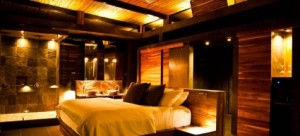
Photo © Christopher P. Baker.
Every time I explore Costa Rica tip to toe while researching each new edition of Moon Costa Rica, I expect to discover one or two new boutique hotels that make me exclaim “Wow!” Usually there’s a stand-out newcomer that raises the bar a few inches. Well, last week I stayed (as the first-ever overnight guest, I’m told) at what will undoubtedly be Costa Rica’s most sensational hotel, period, when it opens in November 2012. In fact, Kurà Design Villas ups the ante by miles.Costa Rica has seen nothing quite as sexy as this.
In fact, the two young Costa Rican owners, architect Martin Wells and his girlfriend Alejandra Umaná, a biologist, describe their creation as having been “designed for sensuality,” by which they mean, not least, as the perfect honeymoon destination.
Reason enough to get married!
Imagine your single-room, open-plan villa (one of only six) as a cube of glass. Stand-alone stone walls separated from the glass cube by water concourses frame the villa sides.
Yes, three walls entirely of glass, end-to-end and floor-to-ceiling and supported on a frame of steel girders enfolded in poured slate-gray concrete. The fourth wall (also of slate-gray concrete) holds the walk-in closet and toilet. A bamboo-lined ceiling brings the tropics indoors. And your king-size bed with luxurious linens seems to float in the center of the room atop a pewter-black slate floor.
Each villa’s “bathroom” is en-suite, as is the walk-in, all-glass-enclosed, him-and-her rainfall-style shower—how sexy is that?—which opens directly onto an expansive balcony. Your terrace also features a low pillar-less wall of glass, all the better for enjoying the spectacular views—which rival any other hotel in the country—along the length of the Costa Ballena.
The hotel nestles high above Uvita on a ridge of the Fila Costeña mountains, along Costa Rica’s Central Pacific coast. It looks down directly upon the famous ‘whale-tail’ tombolo of Uvita.
Getting to the hotel up the steep dirt-and-rock mountain road is a 4WD adventure.
I overnighted in one of two junior suites, permitting me tree-canopy vistas of toucans and other critters, and the coast beyond, which I enjoyed from my expansive terrace while lazing in a two-person hammock.
The jaw-dropping minimalist architecture extends to the “Pool Lounge,” which doubles as the hotel restaurant and looks over the travertine (read, cool underfoot) sundeck, with its L-shaped 62-feet-long, horizon-edge saltwater pool overhanging the ridge-top. The facility, with its columns and floors of slate-gray concrete, is enclosed by glass panel doors that slide back like a concertina and… voilà, the space is thus wall-less.
The name Kurà is a Boruca Indian term. Oversize Boruca balsa devil masks are the sole decorative element, fusing local indigenous style into the hotel’s clean tropical minimalism.
When I visited, the final details of construction were being addressed, and staff from the management company—Cayuga Sustainable Hospitality (which manages eco-friendly hotels throughout Costa Rica and Nicaragua)—were on hand to test menus and train the local staff.
As befits all Cayuga’s properties, Kurà is built in harmony with its pristine surroundings. Not least, power comes from vast solar panels discretely tucked out of view.
Sure, it will be among the most expensive hotels in the country (rates will begin at $440 in the May—October green season, and $640 in the November–April high season). But this is one sensational hotel worth every penny.